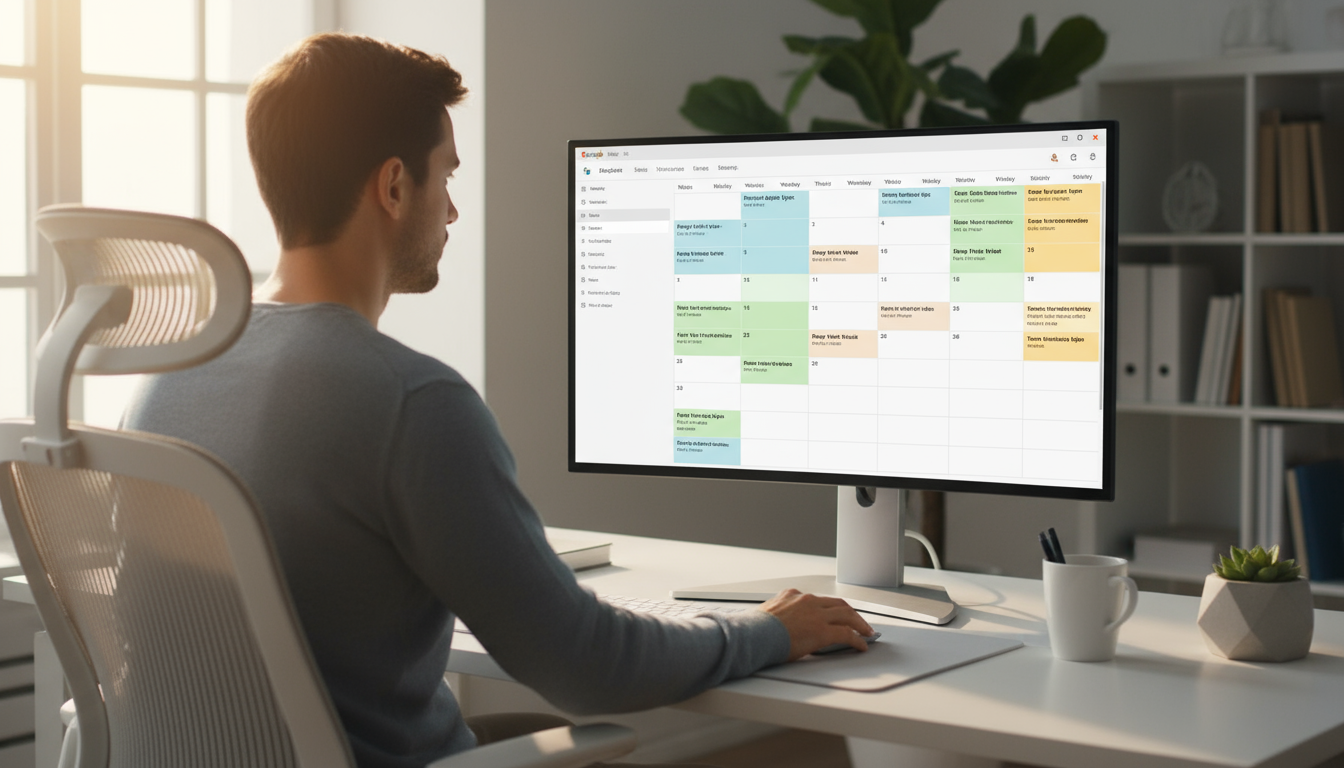
Do you ever get that feeling on Sunday afternoon? A quiet wave of anxiety that starts to build as you think about the week ahead. It’s the weight of deadlines, the flood of emails you know is coming, and the juggling act of work, life, and everything in between. You have a to-do list a mile long, but no clear plan for how to tackle it. You feel reactive, pulled in a dozen directions before you’ve even had your Monday morning coffee.
This feeling is especially common for busy professionals and students living in fast-paced environments. Your schedule isn’t entirely your own. A surprise meeting can derail your day. A last-minute project can upend your priorities. Traditional, rigid planning systems often break under this kind of pressure, leaving you feeling more disorganized than when you started.
But what if there was a better way? What if you could spend less than an hour on Sunday to create a flexible framework for your week? A plan that gives you structure but doesn’t shatter the moment life happens. A system that helps you focus on what truly matters, so you can end each day feeling accomplished instead of exhausted.
At TheFocusedMethod.com, we believe in pragmatic solutions that fit the realities of modern life. This guide will walk you through a simple, three-step sunday routine designed to help you prepare for a successful week. It’s not about creating a perfect, unchangeable schedule. It’s about building a roadmap that guides your decisions, protects your focus, and gives you the confidence to handle whatever the week throws at you.
📚 Table of Contents
- Step 1: The ‘Mind Dump’ and 80/20 Triage
- Step 2: The ‘Blueprint’ – Building Your Ideal Week with Time Blocks
- Step 3: The ‘Flex and Flow’ – Living the Plan and Adapting
- The Weekly Review: Your Secret Weapon for Optimization
- Real-World Scenarios: Applying The Method
- Frequently Asked Questions (FAQ)
- What if my whole day is packed with meetings?
- How strict should I be with my time blocks?
- What’s the best tool for this? A digital calendar or a paper planner?
- This sounds like a lot of work. How long does this Sunday routine take?
- What about spontaneous fun or relaxation? Doesn’t this schedule kill spontaneity?
- Your First Step to a Focused Week

Step 1: The ‘Mind Dump’ and 80/20 Triage
Before you can organize your week, you need to know what you’re working with. Most of our stress comes from the open loops and unresolved tasks swirling around in our heads. The first step in our sunday routine for productivity is to get all of that noise out of your mind and onto paper (or a screen).
This is the Mind Dump. For ten to fifteen minutes, write down every single thing you need to do, want to do, or are worried about for the coming week. Don’t filter or organize it yet. Just let it flow. This includes work projects, personal errands, calls you need to make, bills to pay, appointments to schedule, and creative ideas you want to explore. Your list might include items like “Finish the quarterly report,” “Email HR about benefits,” “Buy groceries,” “Call mom,” and “Research new software.” Get it all out.
Once your mind is clear, it’s time for the triage. Looking at that massive list can be overwhelming, but we are not going to try to do everything. Instead, we’ll apply a powerful concept known as the 80/20 Principle. Also called the Pareto Principle, this idea suggests that, in many situations, roughly 80% of the results come from 20% of the effort. Our goal is to identify that vital 20%.
Scan your master list and ask yourself: “If I could only accomplish three things this week to feel successful and move my goals forward, what would they be?” These are your ‘Big Rocks’ or Most Important Tasks (MITs). These are the tasks that create the most value, reduce the most stress, or unlock the most progress. They are the 20% that will deliver 80% of the impact.
For example, “Finish the quarterly report” is likely a Big Rock. “Organize my desktop files” is probably not. “Prepare for the major client presentation” is a Big Rock. “Respond to every non-urgent email” is not. Identify your one to three Big Rocks for the week. This simple act of prioritization transforms a chaotic to-do list into a focused mission. You now know what winning the week looks like. This is the foundation of how to plan your week effectively.

Step 2: The ‘Blueprint’ – Building Your Ideal Week with Time Blocks
With your priorities clear, it’s time to create a blueprint for your week. We’re going to move beyond a simple to-do list and build a concrete plan using a technique called Time Blocking. This is the core of effective week planning.
Time Blocking is the practice of scheduling specific blocks of time in your calendar for specific tasks or activities. Instead of working from an endless list, you assign every part of your day a job. Your calendar becomes a visual map of how you will invest your time. This method is powerful for two reasons. First, it helps combat Parkinson’s Law, which is the old adage that work expands to fill the time available for its completion. By giving a task a specific container (e.g., 90 minutes), you create a sense of urgency and focus. Second, it dramatically reduces Context Switching, the mental tax you pay every time you shift your attention between different types of tasks. Grouping similar activities together allows your brain to stay in one mode for longer, improving both speed and quality of work.

Setting Up Your Digital Calendar
Your calendar is your most powerful tool. Let’s set it up for success. We recommend using a digital calendar like Google Calendar or Outlook for its flexibility. Start by creating a simple color-coding system to see your week at a glance. For example:
Green for Deep Work: High-focus, cognitively demanding tasks like writing, coding, or strategic thinking.
Blue for Meetings & Calls: Collaborative or reactive work with others.
Gray for Shallow Work: Administrative tasks like email, booking travel, or filling out forms.
Yellow for Personal: Meals, workouts, errands, and family time.
Before you schedule any work, block out your non-negotiables. This is crucial for building a sustainable, realistic schedule. Block out your ideal sleep and wake times. Schedule your meals. Put your commute on the calendar. Block time for your workout. By putting these personal commitments in first, you treat them with the same importance as a business meeting, ensuring you don’t sacrifice your well-being for productivity.
Finally, build in buffer time. Life is unpredictable. Meetings run late, tasks take longer than expected. Schedule 15-minute buffers between major blocks. This gives you time to transition, grab a coffee, stretch, or handle small interruptions without throwing your entire day off track.

Placing Your ‘Big Rocks’
Now, let’s schedule your most important work. Look at the one to three ‘Big Rocks’ you identified in Step 1. These deserve your best energy. When during the week are you most focused and alert? For many, it’s early in the morning. For others, it might be mid-afternoon. Be honest about your own energy patterns.
Schedule these Big Rocks as two- to three-hour “Deep Work” blocks during your peak energy windows. Protect this time fiercely. For example, you might block “Draft Quarterly Report” for Tuesday from 9 AM to 11 AM. Here, we can also use a related technique called Timeboxing. Timeboxing means setting a fixed, maximum amount of time for an activity. You might say, “I will work on the report for 90 minutes and then stop, no matter what.” This makes daunting tasks feel more manageable and prevents them from consuming your entire day.

Filling in the Gaps
With your Big Rocks and non-negotiables on the calendar, you can now fill in the remaining gaps. This is where you schedule your shallow work. Instead of checking email every 15 minutes, batch it. Create one or two 30-minute “Email & Comms” blocks per day. Group all your phone calls into another block. Schedule a “Life Admin” block on Friday afternoon to pay bills and book appointments.
By the end of this step, your calendar should look like a complete, colorful mosaic. It’s a visual representation of your priorities and a realistic plan for how you will invest your time and energy for a successful week.

Step 3: The ‘Flex and Flow’ – Living the Plan and Adapting
A plan is useless if it can’t withstand contact with reality. The final, and perhaps most important, step of this sunday routine is learning to execute your plan with flexibility. Your calendar is your guide, not your dictator. The goal is to be intentional, not to be a robot. The true power of this system lies in how you adapt when things don’t go according to plan.

A Walkthrough of a Typical Day
Let’s imagine it’s Tuesday. Your calendar has a 9 AM to 11 AM deep work block to “Draft Quarterly Report.” When you start your day, you honor that block. You turn off notifications, close your email tab, and focus solely on the report. Because you planned this, you can work without guilt or the nagging feeling you should be doing something else.
At 11 AM, your block ends. You have a 15-minute buffer before your 11:15 AM team meeting. You use this time to stand up, stretch, and quickly scan your inbox for anything truly urgent. You go into your meeting prepared and present. After the meeting, you have another buffer before your lunch block, which you use to decompress and make notes.
Then, in the afternoon, the unexpected happens. Your boss messages you with an urgent request that needs to be handled today. This is where a rigid plan breaks. But with our flexible blueprint, you simply adapt. You look at your calendar. You have a “Shallow Work” block scheduled from 2 PM to 3 PM. You decide this new urgent task is more important. You make a conscious choice to replace that block with the urgent task. The shallow work you planned can be moved to a less critical time tomorrow. You’ve handled the emergency without derailing your entire week because you had a structure to adjust from.

Guardrails for Real Life
Adapting to the real world requires a few key “guardrails” to keep you on track.
Handling Interruptions: When a colleague stops by your desk or sends you a “quick question” message while you’re in a deep work block, you need a default response. Acknowledge their request, capture it, and protect your block. You can say, “I’m in the middle of something focused right now, but I can definitely look at that this afternoon. Can I get back to you around 3 PM?” This shows respect for their needs while also respecting your own planned priorities.
When Meetings Take Over: Inevitably, someone will schedule a meeting right over a planned deep work session. Don’t just let your focus time disappear. Your immediate next action should be to find a new home for that deep work block on your calendar. Drag and drop it to another open slot later in the week. The rule is simple: if focus time is displaced, it must be rescheduled, not deleted.
Handling Overruns: What happens when a task takes longer than its assigned block? You have two choices. You can either extend the block, which means you must consciously decide which subsequent block gets pushed or shortened. Or, you can stop when the time is up (honoring your timebox) and schedule a new block later to finish the remaining work. The key is making an active, intentional decision rather than letting one task’s overrun passively destroy the rest of your day’s plan.

The Weekly Review: Your Secret Weapon for Optimization
Your sunday routine isn’t just about planning the week ahead; it’s also about learning from the week that just passed. Before you build your blueprint for the next week, you must perform a quick Weekly Review. This 15-minute reflection is what turns good planning into a truly optimized personal productivity system. It ensures your week planning gets smarter every single week.
Look back at your calendar from the past seven days. Don’t judge yourself. Just observe with curiosity. Ask a few simple questions: What went well? Where did I get stuck? What did I accomplish that I’m proud of? When did I feel the most energized and focused? When did I feel drained and distracted? This process of self-reflection is critical for sustainable performance. The American Psychological Association (APA) emphasizes that self-awareness is a cornerstone of managing stress and improving effectiveness.
As you review, pay attention to a few key metrics. These aren’t about being rigid; they’re about gathering data to make better decisions for the following week.
Energy Levels: Look for patterns. Did you consistently feel brilliant on Wednesday mornings but sluggish on Friday afternoons? If so, that’s valuable data. You should schedule your most important deep work for Wednesday mornings next week and reserve Friday afternoons for lighter, administrative tasks. You’re learning to work with your natural energy cycles, not against them.
Deep Work Count: How many of your planned deep work sessions did you successfully complete? If you planned five but only managed to do two, why? Were you interrupted? Were your blocks too long? Were you just not feeling motivated? Understanding the “why” helps you create a more realistic plan for the upcoming week. Maybe you start with just three deep work blocks instead of five, focusing on quality over quantity.
Rollover Rate: How many tasks did you have to push from one day to the next? A little bit of rollover is normal; life happens. But if you’re constantly pushing the majority of your tasks, it’s a sign that you’re being overly optimistic. Your time blocks might be too short, you’re not including enough buffer time, or you’re simply trying to cram too much into a single day. Use this insight to schedule a lighter load for the next week, focusing on your true Big Rocks.
This weekly review is the feedback loop that makes the entire system work. It transforms your Sunday planning from a static, one-time event into a dynamic, evolving practice that adapts to you and your life.

Real-World Scenarios: Applying The Method
Theory is great, but let’s see how this sunday routine works in practice for two very different people. This is how to plan your week when your life has specific constraints and demands.

Scenario 1: The Hybrid Professional (Maria)
Challenge: Maria works for a tech company. She’s in the office on Tuesdays and Thursdays for meetings and collaborative work, and she works from home on Mondays, Wednesdays, and Fridays. Her biggest struggle is context switching between the highly social, interruption-driven office days and the quiet, focus-oriented remote days.
Sunday Routine Application: During her Sunday planning session, Maria’s first step is to define her Big Rock for the week: “Finalize the Q3 marketing strategy deck.” She knows this requires uninterrupted deep work. Looking at her week, she immediately protects her remote days. She blocks out 9 AM to 12 PM on Monday and Wednesday for “Strategy Deck Deep Work.” She color-codes these green.
Next, she embraces the nature of her in-office days. Instead of fighting the interruptions, she plans for them. She blocks her Tuesdays and Thursdays with back-to-back blue “Meeting” blocks and gray “Team Sync & Comms” blocks. She intentionally leaves less time for focused work on these days. Her commute time is blocked out in yellow as “Podcast & Transition Time,” allowing her to mentally switch gears between home and office.
By designing her week around her hybrid schedule, Maria stops feeling frustrated. She leverages her quiet days for deep thinking and her office days for collaboration, creating a more effective and less stressful work week.

Scenario 2: The University Student (Leo)
Challenge: Leo is a second-year engineering student. His schedule is a mix of fixed, multi-hour lab sessions and lectures, combined with huge, unstructured blocks of time that he needs to use for studying, problem sets, and a major term paper. He often feels paralyzed by the sheer amount of unstructured time and ends up procrastinating.
Sunday Routine Application: Leo starts his Sunday routine by putting all his non-negotiables on the calendar first. All his lectures, labs, and his part-time job shift are blocked out. This shows him exactly what he has to work with. His Big Rock for the week is “Complete Chapter 4 Problem Set,” which he knows will be difficult.
He then creates specific, outcome-oriented study blocks. Instead of a vague “Study” block, he creates a green, two-hour block on Tuesday morning labeled “Problem Set: Questions 1-5.” He schedules another one on Thursday afternoon for “Problem Set: Questions 6-10.” This use of timeboxing makes the large assignment feel manageable. He also schedules 90-minute “Library Deep Dive” blocks for term paper research.
Crucially, Leo also schedules his downtime. He blocks out Friday evening as “Social Time” and ensures he has blocks for meals and going to the gym. This prevents burnout and helps him maintain his well-being, which is essential for academic performance. Organizations like the National Institutes of Health (NIH) have extensively researched the link between student well-being and success. By giving every hour a job, Leo turns his intimidatingly open schedule into a clear path to getting his work done without the stress.

Frequently Asked Questions (FAQ)
As you begin implementing your own sunday routine, some questions will naturally come up. Here are answers to some of the most common ones we hear from clients at TheFocusedMethod.com.
What if my whole day is packed with meetings?
This is a common reality for many managers and executives. If your calendar is a wall of back-to-back meetings, the goal shifts from finding large deep work blocks to strategically creating small “focus pockets.” Can you block the first 30 minutes of your day, before anyone else is online, to review your priorities and answer one critical email? Can you use the 15 minutes between meetings to make a decision or provide feedback, rather than randomly browsing the news? The principle remains the same: be intentional with the time you do control, no matter how small. If the situation is chronic, it may also be a signal that you need to address your team’s meeting culture directly.
How strict should I be with my time blocks?
Think of your plan as a strong suggestion from your “Sunday Self” – the calm, strategic version of you. The goal is not 100% adherence; it’s 100% intentionality. When you start, it’s helpful to be quite strict to build the habit. But as you get comfortable, the real skill is learning when to stick to the plan and when to consciously deviate. If you get into a state of flow on a project, it might make sense to extend that block. If an unexpected opportunity for collaboration arises, it might be wise to take it. The key is that you are making the decision, rather than letting the day’s chaos make it for you.
What’s the best tool for this? A digital calendar or a paper planner?
The best tool is always the one you will consistently use. Each has its advantages. Digital calendars are fantastic for their flexibility—you can easily drag and drop blocks, set reminders, and share your schedule. Paper planners offer a powerful tactile experience; the physical act of writing can improve clarity and commitment. Many people find a hybrid approach works best. They use a digital calendar for fixed appointments and meetings, and a paper planner (like a daily docket) to map out the tasks within the time blocks they’ve set for that specific day. Experiment and find what feels most natural to you.
This sounds like a lot of work. How long does this Sunday routine take?
When you’re first starting, be prepared to invest about 45 to 60 minutes in your sunday routine for productivity. It will feel slow as you think through your priorities and learn the mechanics of time blocking. However, like any skill, it gets faster with practice. After a few weeks, most people can complete their weekly review and plan in just 25 to 30 minutes. Consider it a high-leverage investment. That half-hour on Sunday will save you hours of wasted time, stress, and decision fatigue during the week.
What about spontaneous fun or relaxation? Doesn’t this schedule kill spontaneity?
This is a common fear, but the reality is often the opposite. A well-planned week liberates you from the “tyranny of the urgent” and the persistent, low-grade guilt that you should be doing something more productive. When you know that your important work is scheduled and has a home, you can fully relax and be present in your downtime. You can enjoy a spontaneous dinner with friends without worrying about the project you haven’t started. For true spontaneity, you can even schedule “Flex Time” or “Open” blocks into your week, intentionally creating space for whatever comes your way. Remember, rest is not the absence of productivity; it is a vital part of it. The Sleep Foundation (Sleep Foundation) consistently shows that adequate rest is non-negotiable for high cognitive performance.

Your First Step to a Focused Week
The journey to a more intentional and productive week doesn’t require a massive, overnight change. The Sunday Routine is a simple, flexible framework designed to bring clarity and control back to your life. It’s built on a three-step process: performing a ‘Mind Dump’ to identify your true priorities, building a ‘Blueprint’ with time blocks, and learning to ‘Flex and Flow’ with the realities of your day.
The goal is progress, not perfection. You don’t have to implement this entire system at once. The most important thing is to start small and build momentum. Here are three simple actions you can take this coming Sunday to begin.
1. Just Do the Mind Dump. Forget the rest for now. Simply take 15 minutes this Sunday to write down every single task, worry, and idea in your head. Then, circle the one to three items that would make the biggest positive impact on your week. This step alone can bring a profound sense of clarity and relief.
2. Schedule One Deep Work Block. Look at your most important task for the week. Find a single 90-minute slot in your calendar where you are likely to have good energy. Block it off and label it. Commit to honoring that one appointment with yourself.
3. Add Two Buffers. Look at your busiest day. Find two back-to-back meetings or appointments. Go into your calendar and schedule a 15-minute “Buffer” or “Transition” block between them. Experience the small bit of breathing room it creates.
By taking these small steps, you are starting to build a new habit. You are moving from a reactive to a proactive state. You are telling your time where to go, instead of wondering where it went. Start this Sunday, and build a system that finally works for you and your life.
Disclaimer: The information provided in this article is for informational purposes only and is not intended as a substitute for professional medical, psychological, or legal advice. Always seek the advice of a qualified professional with any questions you may have regarding a medical or legal condition.






